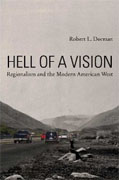Hell of a Vision
Robert L. Dorman
book reviews:
· general fiction
· chick lit/romance
· sci-fi/fantasy
· graphic novels
· nonfiction
· audio books
· author interviews
· children's books @
curledupkids.com
· DVD reviews @
curledupdvd.com
newsletter
win books
buy online
links
home
for authors
& publishers
for reviewers

 |
Hell of a Vision: Regionalism and the Modern American West Robert L. Dorman University of Arizona Press Hardcover 272 pages October 2012 |
|
The American West has a charm all its own, whether it be the sense of freedom of the “wide open spaces” and “big sky” or the ethnic richness of its tri-cultural heritage--or, paradoxically, the sense of racial autonomy and white dominance no better embodied than in the myth of the American cowboy. For me, on my first of many road trips to the West, it was the Pecos River Gorge that first enchanted me and made me understand that, for sure, I wasn’t in North Carolina anymore. Subsequent journeys have convinced me that all Easterners should go West in order to truly understand our heritage. Thus I found this book especially interesting, as it draws together many visions--clear and distorted--of what the West is and what it could or should be.
After the initial years of exploration and settlement, when it seemed Americans had gone about as far as they could, the West suddenly opened up to expansion and colonization. Many envisioned the region as a place for grand social experiments. Others saw it as a fertile ground for tourism: “diversity and exoticism were the stock-in-trade of regionalism, and western regionalism became readily appropriable by commercial interests always on the lookout for new thrills and attractions: cowboys, pioneers, Indians, Spaniards, natural wonders.”It was there that the first national park was founded, that the whole concept of national parklands was introduced and with it the notion of spending one’s vacation looking out of a car window. Unlike the crowded tree-lined East, the West was just too big to be seen close up. Dorman quotes geographer Donald Meinig as stating, “Regions are abstractions, they exist in our minds…” However, for those who inhabit the region–displaced Native American tribes, Hispanics who were here before we were, and others who continue to come in, cattle ranchers, Mormons–the West is a region in reality. Such thorny problems as water rights and cultural distinctions have fractured the Western vision many times over. Yet people still flock there to live, convinced that the dry air is healthy and the natural beauty is a balm for the spirit. The West has been written about (Cather, McCarthy, Sandoz, Steinbeck, Heat-Moon), painted (Catlin, Remington, O’Keefe), photographed (Adams, Lange), politicked, filmed, mapped, zoned, “aspenized,” sung about, conserved, reserved, controlled, planned and idealized far more than other segments of America. It is vibrant in our inner vision as a place of wilderness, excitement, old-fashioned morality, a place where change still might happen. It was in the West, after all, that the atomic age was ushered in, and we had our first visitors from outer space. It is not a static place on a fixed timeline; it continues to grow and re-create itself with dams, manmade lakes, Indian casinos, crazy artificial cities, and the landscape’s own shifting sands. Originally published on Curled Up With A Good Book at www.curledup.com. © Barbara Bamberger Scott, 2012 |
| Also by Robert L. Dorman: |
|
|
|
 Click here to learn more about this month's sponsor! |
|
| fiction · sf/f · comic books · nonfiction · audio newsletter · free book contest · buy books online review index · links · · authors & publishers reviewers |
|
| site by ELBO Computing Resources, Inc. | |
 The book takes its name from the final words of the television miniseries,
Lonesome Dove, a stylistic modern tale of Western nostalgia by Larry McMurtry: "hell of a vision" speaks to the disillusionment with the notion of the West as a "Cattleman's Paradise," one of the many archetypes that author and professor Dorman has identified. From the antebellum idea of the West as the last place where whites could live in separation and domination, to the struggles of our forebears to subsist on the Great Plains just after the Civil War, to the era of movie cowboys and movie Indians, through the Dustbowl migrations into the current day when wealthy migrants seek the good life of skiing and ranching, the West has been repainted many times to suit our changing sociological needs.
The book takes its name from the final words of the television miniseries,
Lonesome Dove, a stylistic modern tale of Western nostalgia by Larry McMurtry: "hell of a vision" speaks to the disillusionment with the notion of the West as a "Cattleman's Paradise," one of the many archetypes that author and professor Dorman has identified. From the antebellum idea of the West as the last place where whites could live in separation and domination, to the struggles of our forebears to subsist on the Great Plains just after the Civil War, to the era of movie cowboys and movie Indians, through the Dustbowl migrations into the current day when wealthy migrants seek the good life of skiing and ranching, the West has been repainted many times to suit our changing sociological needs.